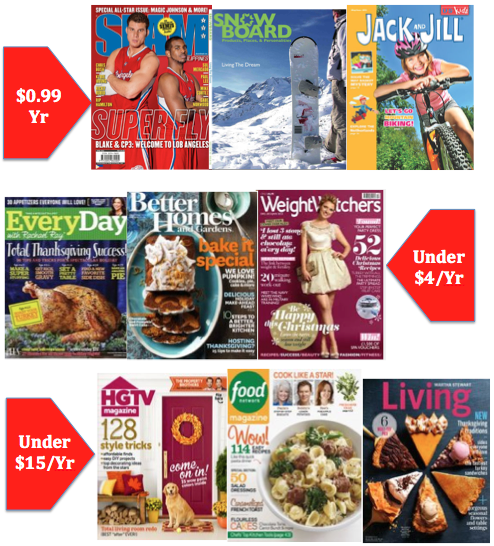One industry analyst believes that those deep subscription discounts are bad news, especially for smaller publishers.
 As the always-intriguing D. Eadward Tree pointed out last summer, there’s one thing that most everybody gets wrong about the newsstand.
As the always-intriguing D. Eadward Tree pointed out last summer, there’s one thing that most everybody gets wrong about the newsstand.
“There are many reasons to distribute copies for retail sale, and most have little to do with actually selling copies,” Tree explained. “One of the main benefits of newsstand distribution is finding new subscribers for a magazine, both from newsstand buyers and newsstand browsers.”
And a subscriber, Tree notes, is worth far more to a publisher than the casual reader, justifying those deeply discounted subscription offers.
“A subscriber can be renewed (at higher rates), sold other subscriptions, signed up for newsletters, and lured to events. And her name can be rented to other publishers and marketers. (Shhh, don’t tell.),” he noted in signature Tree style.
On the other hand, there are some who believe this approach, when taken to the extreme, can do far more harm to publishers than good.
“Recently I was going through the F.S.I.’s (Free Standing Inserts) in my Sunday (print) newspapers, when I came across an astounding offer from Hearst magazines,” writes John Morthanos in Publishing Executive. “’Enjoy One Year of O, The Oprah Magazine (12 issues) for $8 and Save Even More, Add a year of Good Housekeeping for Just $2 More!’”
“Let’s break down the math,” Morthanos continues. “That’s 24 issues of two magazines for $10, or $0.42 per copy that’s printed, labeled, and mailed to your door. For two years of O, The Oprah Magazine plus Good Housekeeping it’s $0.19 per copy printed and mailed to your home!”
His issue with this approach is that many smaller publishers simply don’t have the resources to fulfill those deeply discounted subscriptions, even if it does mean raising the base rate to justify higher ad prices. He gives an in-depth example of how this type of approach backfired in his own work at Cowles Magazine; the entire story is worth the read.
“Is it any wonder that retailers are hesitant to embrace print products, when publishers are so quick to undercut their retail sales?” he asks.
It’s a valid question. Morthanos is one who definitely understands the current newsstand, as titles like Magnolia, with its hefty cover price, are seeing fantastic success.
“Create an innovative product that consumers want to purchase, like Magnolia Journal. Do not water down successful sales with highly discounted subscription offers,” he advises.
Yes, it’s tempting to offer deep subscription discounts to gain new subscribers, but at what cost to both your newsstand sales and the health of the industry in general?
Create unique magazine content that readers are willing to pay for, create covers that truly speak to your audience, and stay true to your mission. This is the path to a healthy experience on today’s newsstand.

June 7, 2017, 3:33 pm